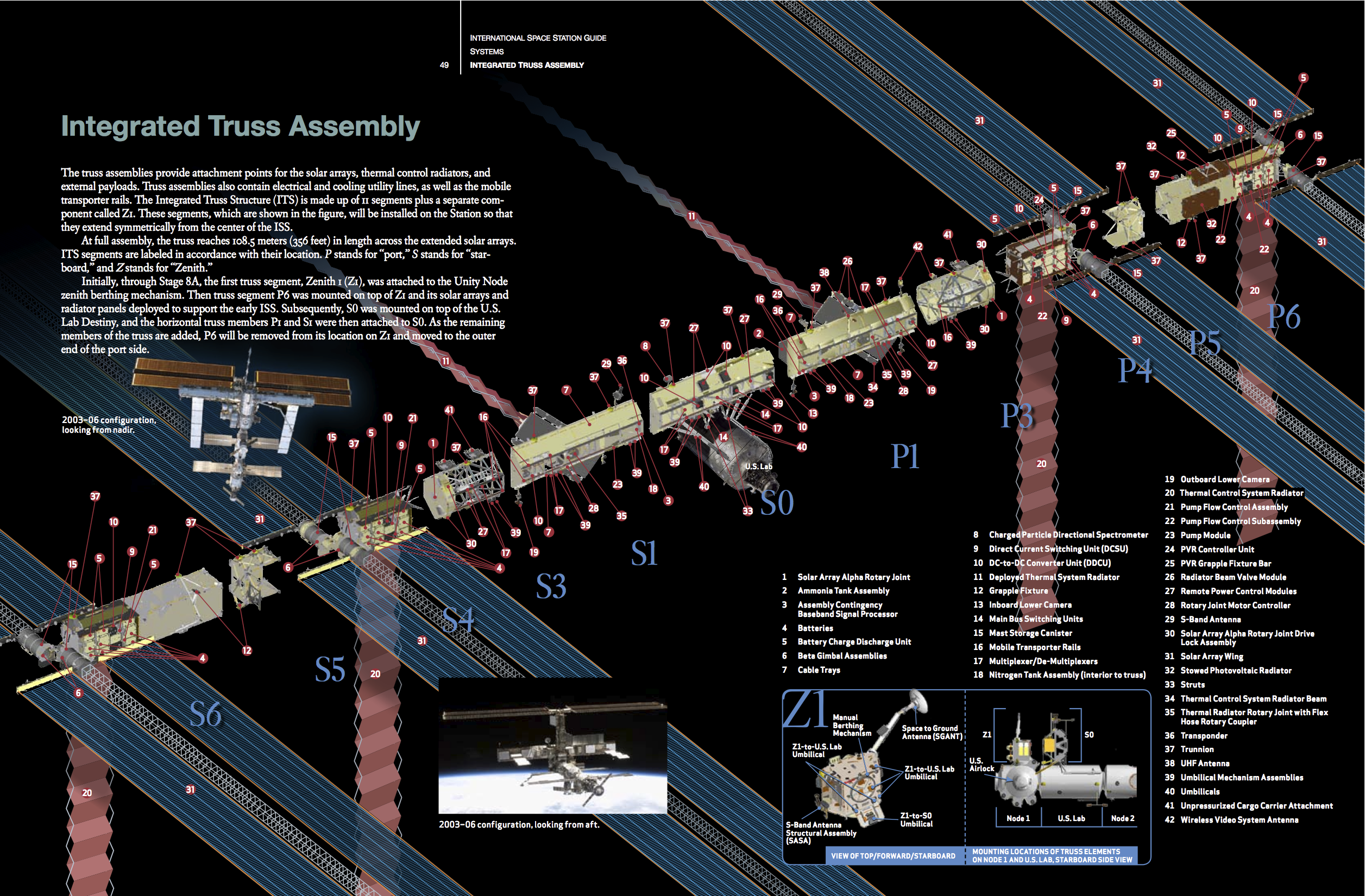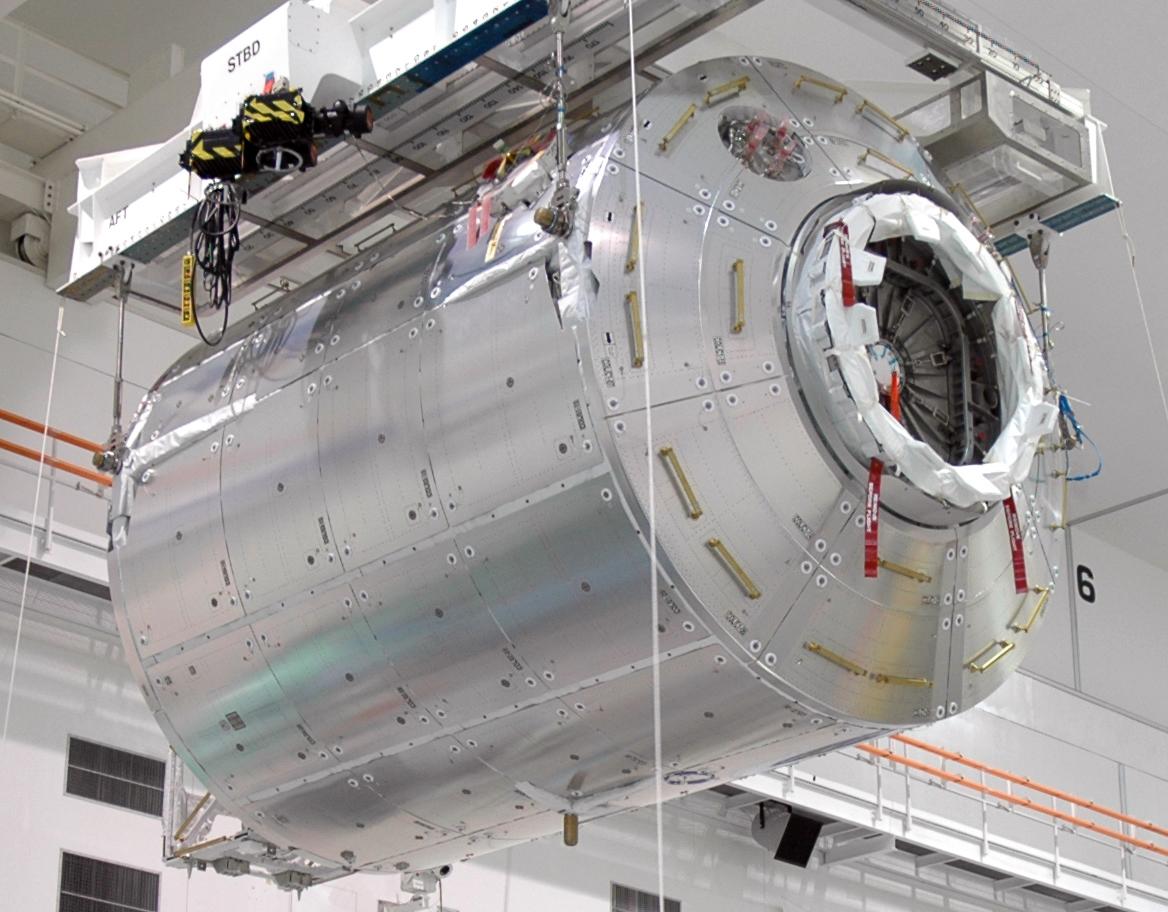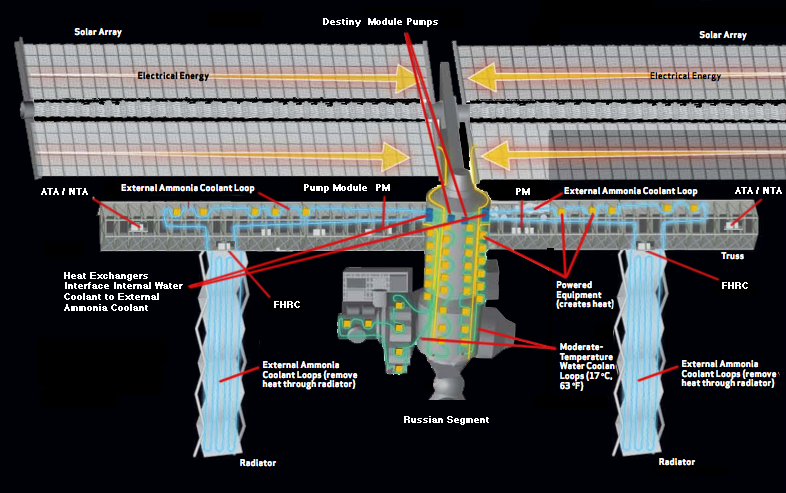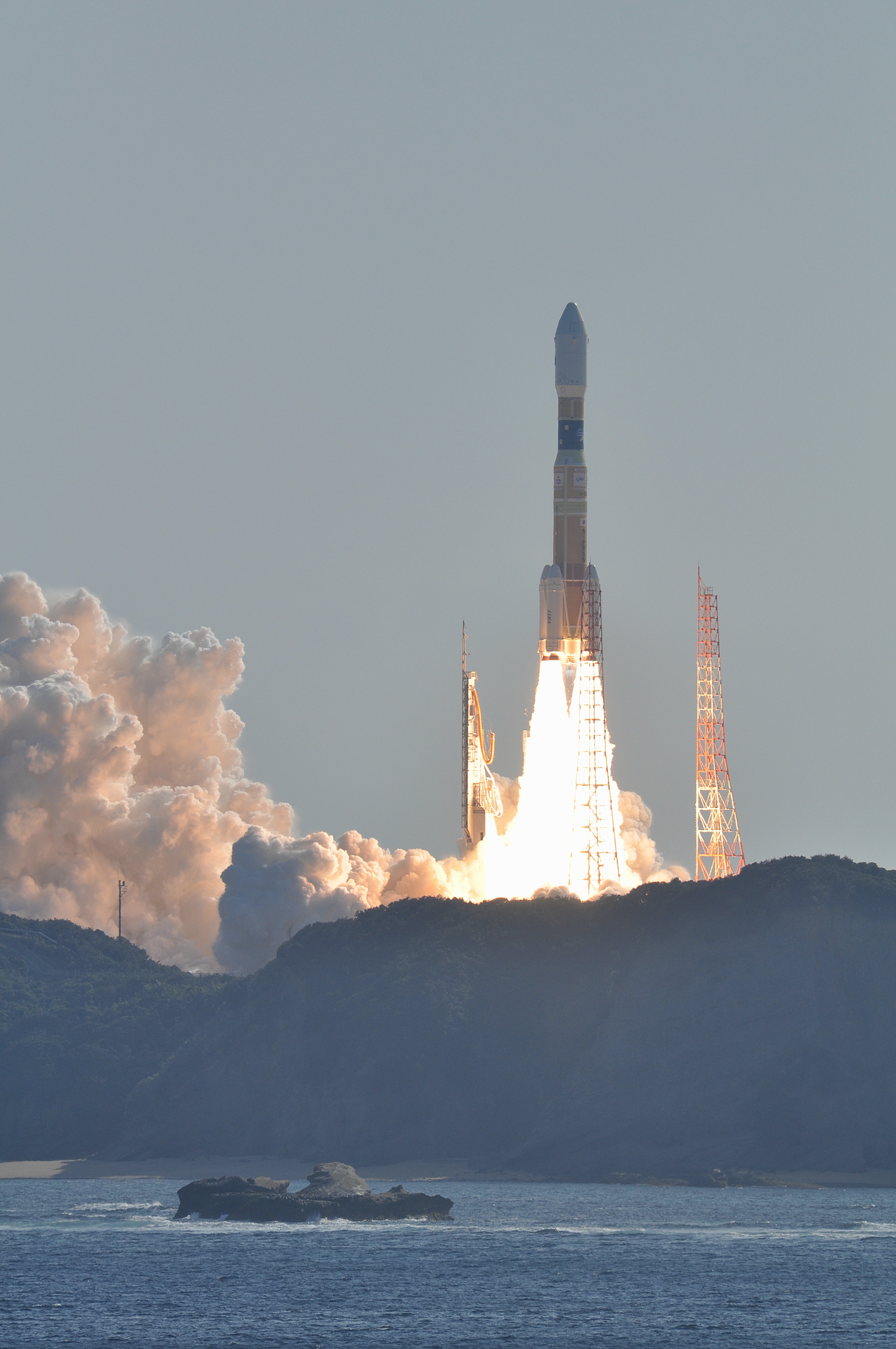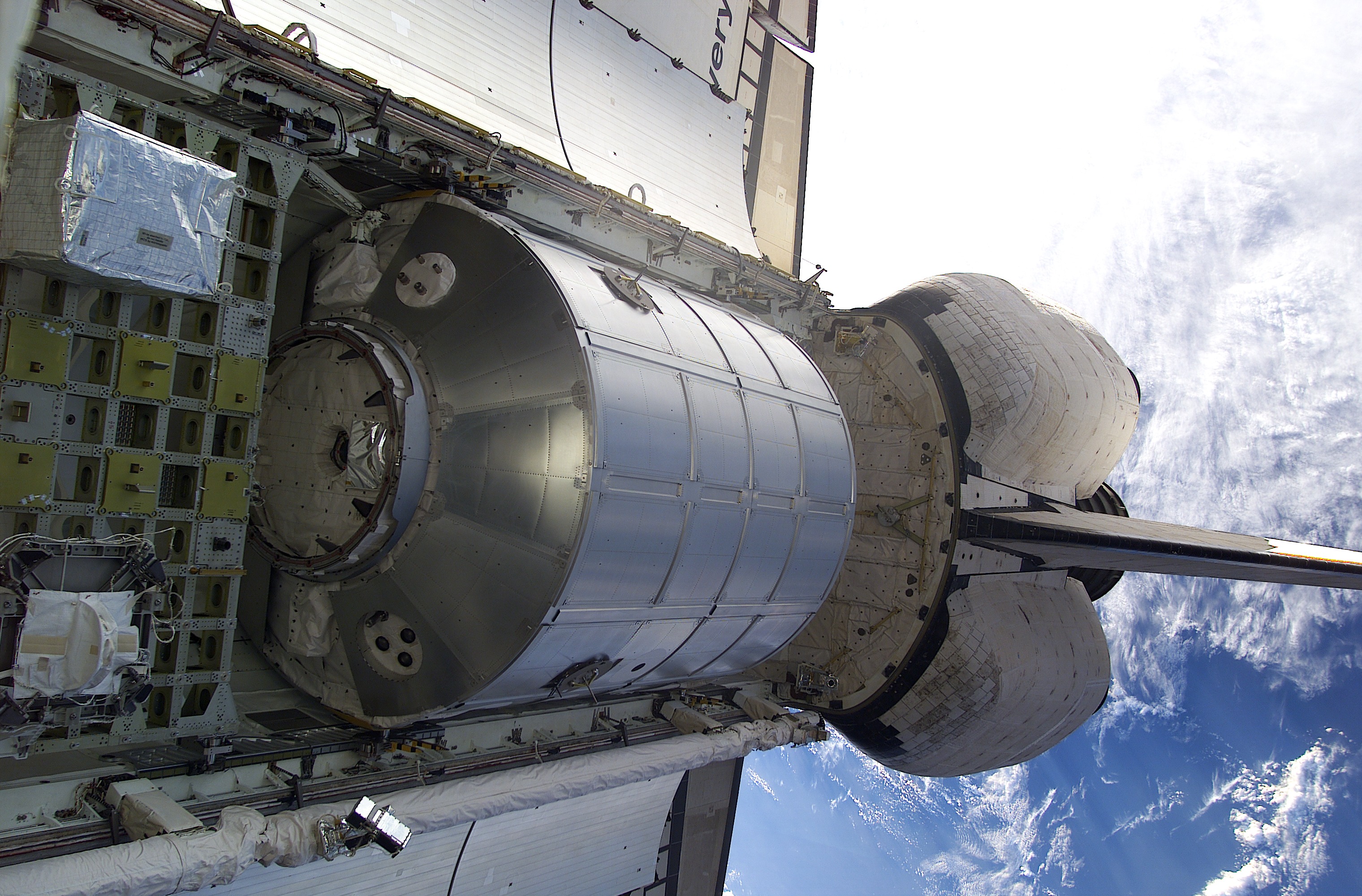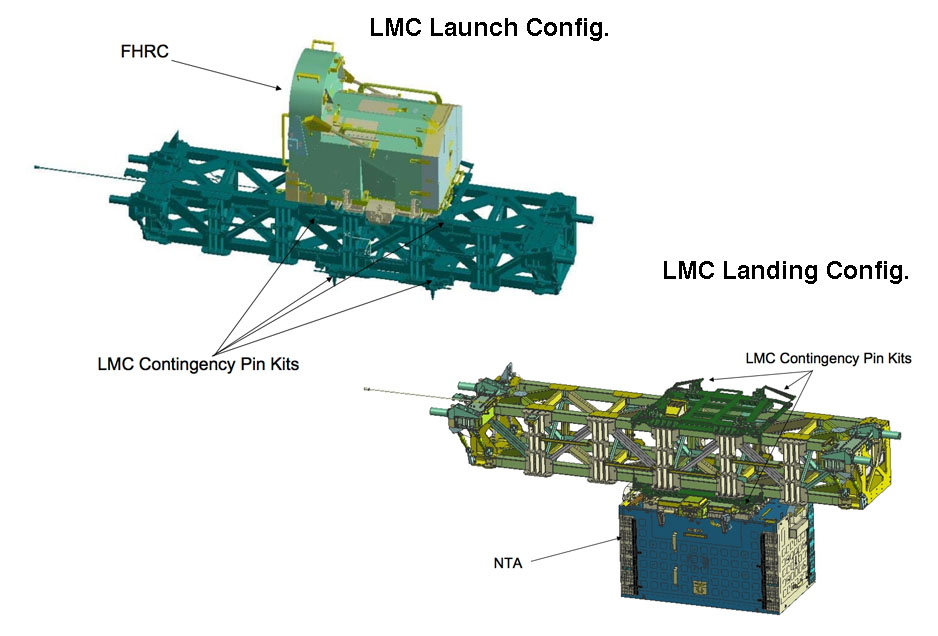|
Orbit-replaceable Unit
Orbital replacement units (or on-orbit replaceable unit) (ORUs) are key elements of the International Space Station that can be readily replaced when the unit either passes its design life or fails. ORUs are parts of the main systems and subsystems of the external elements of the ISS, none are intended to be installed inside the pressurised modules. Examples of ORUs are: pumps, storage tanks, controller boxes, antennas, and battery units. Such units are replaced either by astronauts during EVA or by the Dextre (SPDM) robotic arm. All are stored on the three external stowage platforms (ESPs) or the four ExPRESS Logistics Carriers (ELCs) mounted on the Integrated Truss Structure (ITS). Introduction While spare parts/ORUs were routinely brought up and down during the ISS life-time via Space Shuttle resupply missions, there was a heavy emphasis once the Station was considered complete. Several Shuttle missions were dedicated to the delivery of ORUs using support carrier structures/ ... [...More Info...] [...Related Items...] OR: [Wikipedia] [Google] [Baidu] |
International Space Station
The International Space Station (ISS) is a large space station that was Assembly of the International Space Station, assembled and is maintained in low Earth orbit by a collaboration of five space agencies and their contractors: NASA (United States), Roscosmos (Russia), European Space Agency, ESA (Europe), JAXA (Japan), and Canadian Space Agency, CSA (Canada). As the largest space station ever constructed, it primarily serves as a platform for conducting scientific experiments in microgravity and studying the space environment. The station is divided into two main sections: the Russian Orbital Segment (ROS), developed by Roscosmos, and the US Orbital Segment (USOS), built by NASA, ESA, JAXA, and CSA. A striking feature of the ISS is the Integrated Truss Structure, which connect the station’s vast system of solar panels and Spacecraft thermal control, radiators to its pressurized modules. These modules support diverse functions, including scientific research, crew habitation, ... [...More Info...] [...Related Items...] OR: [Wikipedia] [Google] [Baidu] |
STS-122
STS-122 was a NASA Space Shuttle mission to the International Space Station (ISS), flown by the . STS-122 marked the 24th shuttle mission to the ISS, and the 121st Space Shuttle flight overall. The mission was also referred to as ISS-1E by the ISS program. The primary objective of STS-122 was to deliver the ESA, European ''Columbus (ISS module), Columbus'' science laboratory, built by the European Space Agency (ESA), to the station. It also returned Expedition 16 Flight Engineer Daniel M. Tani to Earth. Tani was replaced on Expedition 16 by Léopold Eyharts, a French Flight Engineer representing ESA. After ''Atlantis'' landing, the orbiter was prepared for STS-125, the final servicing mission for the Hubble Space Telescope. The original target launch date for STS-122 was December 6, 2007, but due to engine cutoff sensor (ECO) reading errors, the launch was postponed to December 9, 2007. During the second launch attempt, the sensors failed again, and the launch was halted. A tanki ... [...More Info...] [...Related Items...] OR: [Wikipedia] [Google] [Baidu] |
Canadarm2
The Mobile Servicing System (MSS) is a robotic system on board the International Space Station (ISS). Launched to the ISS in 2001, it plays a key role in station assembly and maintenance; it moves equipment and supplies around the station, supports astronauts working in space, services instruments and other payloads attached to the ISS, and is used for external maintenance. Astronauts receive specialized training to perform these functions with the various systems of the MSS. The MSS is composed of three components: * the Space Station Remote Manipulator System (SSRMS), known as Canadarm2. * the Mobile Remote Servicer Base System (MBS). * the Dextre, Special Purpose Dexterous Manipulator (SPDM, also known as "Dextre" or "Canada hand"). The system can move along rails on the Integrated Truss Structure on top of the US-provided Mobile Transporter cart, which hosts the MRS Base System. The system's control software was written in the Ada (programming language), Ada 95 programming ... [...More Info...] [...Related Items...] OR: [Wikipedia] [Google] [Baidu] |
Grapple Fixture
Grapple fixtures are used on spacecraft or other objects to provide a secure connection for a Articulated robot, robotic arm. North America The fixtures allowed the Space Shuttle, Space Shuttle's Canadarm (also known as the Shuttle Remote Manipulator System, or SRMS) to safely grapple large objects (e.g. ISS components, or satellites e.g. Hubble Space Telescope, HST). They currently do the same for the International Space Station's Mobile Servicing System#Canadarm2, Space Station Remote Manipulator System (SSRMS) (also known as Canadarm2) and the Kibo (ISS module)#Remote Manipulator System, Japanese Experiment Module Remote Manipulator System (JEMRMS). The grapple fixtures are flat in appearance, with a central grapple pin topped with a sphere which the snares in the end of the arms latch on to. They use three "ramps" that help guide the robotic arm correctly onto the grapple fixture. Development The North American grapple fixture was developed at Spar Aerospace in the 1970s. It ... [...More Info...] [...Related Items...] OR: [Wikipedia] [Google] [Baidu] |
Environmental Control And Life Support System
Environment most often refers to: __NOTOC__ * Natural environment, referring respectively to all living and non-living things occurring naturally and the physical and biological factors along with their chemical interactions that affect an organism or a group of organisms Other physical and cultural environments *Ecology, the branch of ethology that deals with the relations of organisms to one another and to their physical surroundings *Environment (systems), the surroundings of a physical system that may interact with the system by exchanging mass, energy, or other properties. *Built environment, constructed surroundings that provide the settings for human activity, ranging from the large-scale civic surroundings to the personal places *Social environment, the culture that an individual lives in, and the people and institutions with whom they interact *Market environment, business term Arts, entertainment and publishing * ''Environment'' (magazine), a peer-reviewed, popular e ... [...More Info...] [...Related Items...] OR: [Wikipedia] [Google] [Baidu] |
External Active Thermal Control System
The International Space Station (ISS) External Active Thermal Control System (EATCS) maintains an equilibrium when the ISS environment or heat loads exceed the capabilities of the Passive Thermal Control System (PTCS). Note Elements of the PTCS are external surface materials, insulation such as Multi-Layer Insulation (MLI), or Heat Pipes. The EATCS provides heat rejection capabilities for all the U.S. pressurized modules, the Japanese Experiment Module (JEM), the Columbus Orbital Facility (COF), and the main power distribution electronics of the S0, S1 and P1 Trusses. The EATCS consists of two independent Loops (Loop A & Loop B), which both use mechanically pumped fluid state ammonia in closed-loop circuits. The EATCS is capable of rejecting up to 70 kW, and provides a substantial upgrade in heat rejection capacity from the 14 kW capability of the Early External Active Thermal Control System (EEATCS) via the Early Ammonia Servicer (EAS), which was launched on STS-1 ... [...More Info...] [...Related Items...] OR: [Wikipedia] [Google] [Baidu] |
Kounotori 4
Kounotori 4, also known as HTV-4, was the fourth flight of the H-II Transfer Vehicle, an uncrewed cargo spacecraft launched in August 2013 to resupply the International Space Station. It launched from Tanegashima Space Center aboard H-IIB No. 4 (H-IIB F4) rocket on 3 August 2013 and connected to ISS by 9 August 2013; it carried of cargo. Kounotori 4 undocked on 4 September 2013 and was destroyed by reentry on 7 September 2013. Specifications Major changes of Kounotori 4 from previous HTV are: * Although the previous Kounotori 3 used reaction control system (RCS) thrusters by IHI Aerospace, Kounotori 4 uses the RCS manufactured by Aerojet, similar to HTV-1 and Kounotori 2. This will be the last Kounotori to use Aerojet parts, and future Kounotori are to use IHI's. * One of the solar panels was replaced with a sensor module to measure the surface electrical potential when berthing to ISS. * Continued improvement of ground operation to allow more late access cargo. * ... [...More Info...] [...Related Items...] OR: [Wikipedia] [Google] [Baidu] |
Kounotori 2
Kounotori 2 (こうのとり2号機, "white stork"), also known as HTV-2, was launched in January 2011 and was the second flight of the Japanese H-II Transfer Vehicle to resupply the International Space Station (ISS). It was launched by the H-IIB Launch Vehicle No. 2 (H-IIB F2) manufactured by Mitsubishi Heavy Industries (MHI) and JAXA. After the supplies were unloaded, Kounotori 2 was loaded with waste material from ISS, including used experiment equipment and used clothes. Kounotori 2 was then unberthed and separated from the ISS and burned up upon reentering the atmosphere on 30 March 2011. Specifications Kounotori 2 is across and about long. It consists primarily of three parts: a Propulsion Module, an Avionics Module, and a Logistics Carrier. The propulsion module is installed at the rear of the Kounotori and is composed of the main engines for orbit change, the reaction control system (RCS) thrusters for positioning and attitude control, fuel and oxidizing reagent tank ... [...More Info...] [...Related Items...] OR: [Wikipedia] [Google] [Baidu] |
STS-135
STS-135 ( ISS assembly flight ULF7) was the 135th and final mission of the American Space Shuttle program. It used the orbiter '' Atlantis'' and hardware originally processed for the STS-335 contingency mission, which was not flown. STS-135 launched on July 8, 2011, and landed on July 21, 2011, following a one-day mission extension. The four-person crew was the smallest of any shuttle mission since STS-6 in April 1983. The mission's primary cargo was the Multi-Purpose Logistics Module (MPLM) '' Raffaello'' and a Lightweight Multi-Purpose Carrier (LMC), which were delivered to the International Space Station (ISS). The flight of ''Raffaello'' marked the only time that ''Atlantis'' carried an MPLM. Although the mission was authorized, it initially had no appropriation in the NASA budget, raising questions about whether the mission would fly. On January 20, 2011, program managers changed STS-335 to STS-135 on the flight manifest. This allowed for training and other mission spe ... [...More Info...] [...Related Items...] OR: [Wikipedia] [Google] [Baidu] |
STS-131
STS-131 ( ISS assembly flight 19A) was a NASA Space Shuttle mission to the International Space Station (ISS). launched on April 5, 2010, at 6:21 am from LC-39A, and landed at 9:08 am on April 20, 2010, on runway 33 at the Kennedy Space Center's Shuttle Landing Facility. The mission marked the longest flight for Space Shuttle ''Discovery'' and its 38th and penultimate flight. The primary payload was a Multi-Purpose Logistics Module loaded with supplies and equipment for the International Space Station. The mission also removed and replaced an ammonia tank assembly outside the station on the S1 truss. STS-131 furthermore carried several on-board payloads; this mission had the most payloads since STS-107. It is also the last shuttle mission with a crew of 7. Crew Crew seat assignments Mission payload Multi-Purpose Logistics Module ''Leonardo'' The primary payload of STS-131 was the Multi-Purpose Logistics Module (MPLM) ''Leonardo''. The MPLM was filled with ... [...More Info...] [...Related Items...] OR: [Wikipedia] [Google] [Baidu] |
STS-128
STS-128 ( ISS assembly flight 17A) was a NASA Space Shuttle mission to the International Space Station (ISS) that launched on August 28, 2009. carried the Multi-Purpose Logistics Module ''Leonardo'' as its primary payload. It was Discovery's 37th flight. ''Leonardo'' contained a collection of experiments for studying the physics and chemistry of microgravity. Three spacewalks were carried out during the mission, which removed and replaced a materials processing experiment outside ESA's '' Columbus'' module, and returned an empty ammonia tank assembly. The mission's first launch attempt was delayed due to weather concerns, including multiple weather violations in NASA's launch rules, beginning over two hours before the scheduled launch. The second launch attempt, scheduled for August 26, 2009, at 01:10:22 EDT, was called off the previous evening due to an anomaly in one of the orbiter's fuel valves. The launch finally took place on August 28, 2009, at 23:59 EDT. ''Discovery'' lan ... [...More Info...] [...Related Items...] OR: [Wikipedia] [Google] [Baidu] |
STS-126
STS-126 was the one hundred and twenty-fourth NASA Space Shuttle mission, and twenty-second orbital flight of the ''Space Shuttle Endeavour'' (OV-105) to the International Space Station (ISS). The purpose of the mission, referred to as ULF2 by the ISS program, was to deliver equipment and supplies to the station, to service the Integrated Truss Structure, Solar Alpha Rotary Joints (SARJ), and repair the problem in the starboard SARJ that had limited its use since STS-120. STS-126 launched on 15 November 2008 at 00:55:39 UTC from Kennedy Space Center Launch Complex 39A, Launch Pad 39A (LC-39A) at NASA's Kennedy Space Center (KSC) with no delays or issues. ''Endeavour'' successfully docked with the station on 16 November 2008. After spending 15 days, 20 hours, 30 minutes, and 30 seconds docked to the station, during which the crew performed four Extravehicular activity, spacewalks, and transferred cargo, the orbiter undocked on 28 November 2008. Due to poor weather at Kennedy Sp ... [...More Info...] [...Related Items...] OR: [Wikipedia] [Google] [Baidu] |
